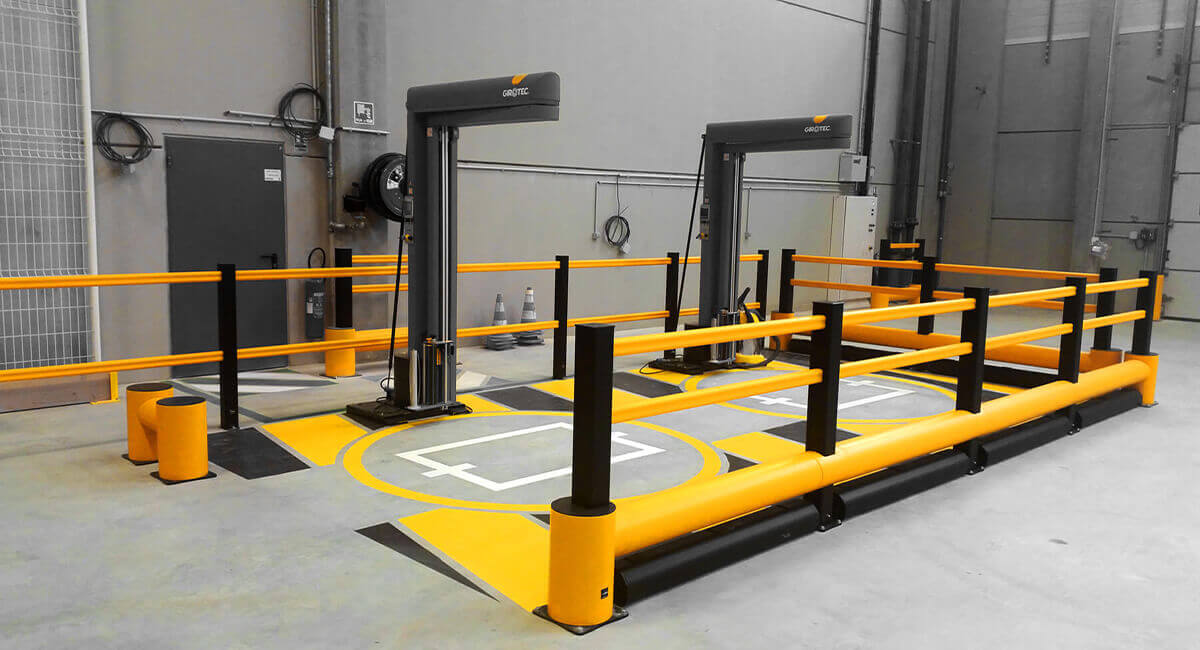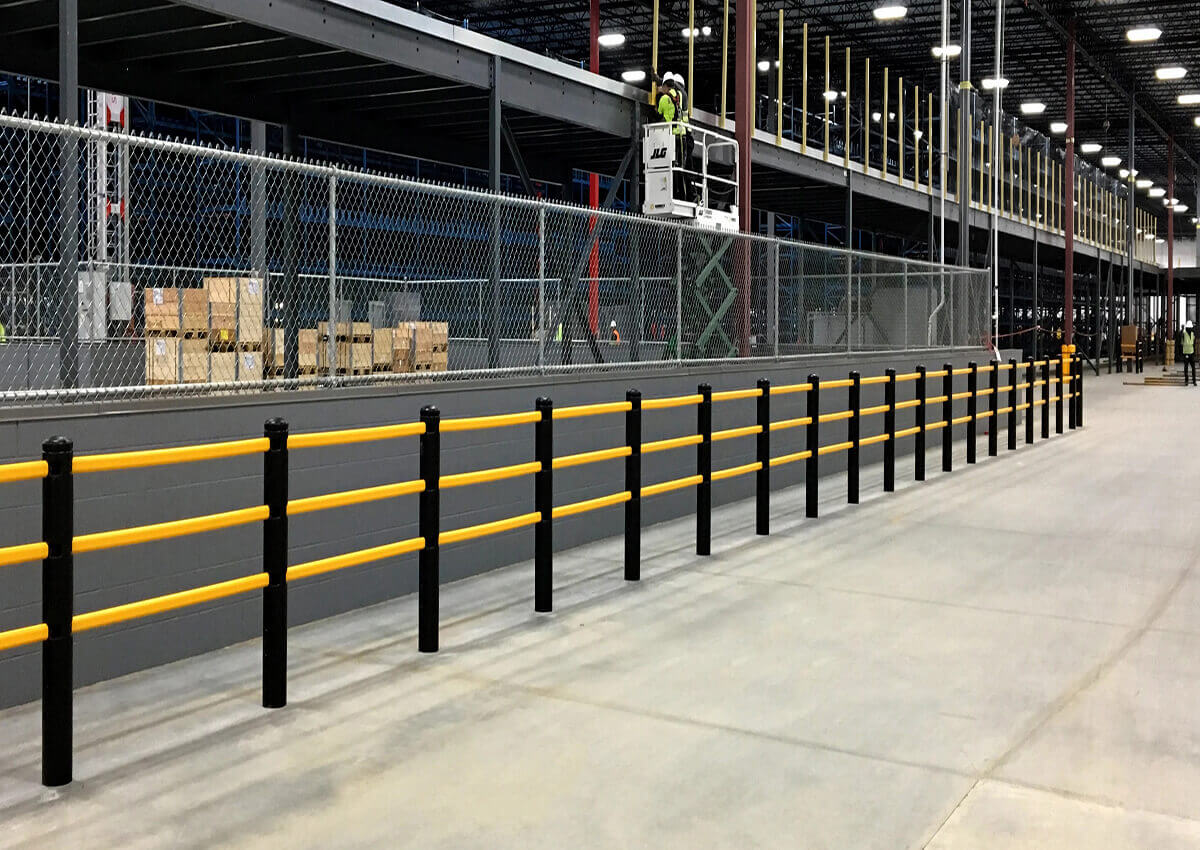Enforcing work health and safety standards in a warehouse is no easy task. As factories and pedestrians move your inventory in and out, the chance of them colliding with each other with tragic results is high. Of course, you must educate your employees to follow a traffic management plan and install warning signs to separate pedestrians and forklifts. Nevertheless, human error can undermine even the best precautions. The good news is that by installing effective warehouse protection barriers around your warehouse, you can radically reduce forklift accidents.
In today’s guide, we’ll discuss why you should install a warehouse protective barrier and common issues with installation. Read on to learn more.
1. Why install warehouse protection barriers?
Operational safety is a fundamental consideration for any warehouse or distribution center, regardless of its size or function. Among the many features that are critical to keeping your facility safe are warehouse protection barriers. In addition to floor markings and signage etc. Warehouse protection barriers can form an important part of any warehouse layout, especially It is the flow of people and vehicles in the space when there is an important warehouse layout.
Warehouse protection barriers range from guardrails and bollards to post guards and security gates, with installation options chosen to suit your needs.

1) Warehouse protection barriers are necessary
In many warehouses and distribution centers, there is a constant flow of people, equipment, and heavy vehicles such as forklifts. Therefore, installing warehouse protection barriers is crucial to ensure personnel safety. Not to mention helping to prevent valuable facilities like warehouse shelves from being damaged.
When planning a warehouse setup, understanding how the facility will operate and deciding where to place protective barriers is important to keep operations running smoothly and safely. Given the investment involved in setting up a warehouse or distribution center and the cost of errors, many companies seek to partner with experienced providers to assist in setting up operations.
This will include planning the distribution, supply, and installation of warehouse protection barriers, racking, signage and floor markings, etc.
Highlighted below are four reasons to use warehouse protection barriers:
2) Comply with established warehouse standards
The warehouse operations manual specifies, among other things, the steps to be followed when loading, unloading, labeling, and organizing products, but also includes mandatory safety standards. Failure to adhere to these procedures means a forced suspension of operations.
Every region has regulations to prevent occupational hazards. In the case of warehouses, this typically involves aisle widths and warehouse floor markings, load capacity of racks, signage, personal protective equipment, and, of course, warehouse protection barriers.
Most importantly, safety barriers are used to delineate areas that could put workers at risk, such as areas where construction is taking place, spaces where hazardous materials are unpacked, or areas where heavy machinery is being used.
3) Protect people
Whether it’s rigid guardrails, flexible bollards, or automated safety gates, delineating and limiting certain hazard areas is critical to taking care of warehouse workers. Almost all accidents involve human error, so this is the focus of risk prevention.
Warehouse protection barriers tell workers where not to cross. This will prevent accidents and increase awareness among personnel. While some of these obstacles may be located in clearly dangerous locations, others are located in areas where the risk is less obvious to the untrained eye.
Generally speaking, protective barriers are yellow or orange because these bright colors help people remain alert and cautious about the areas they delineate or restrict. It’s important to make sure you follow clearly defined and communicated color codes so everyone knows what they mean.
4) Protect cargo
Warehouse protection barriers not only limit areas or spaces that may be dangerous to your personnel, but they also protect the products and materials you store in your warehouse. After all, it’s the lifeblood of your business.
Goods are constantly moving around the warehouse as they arrive, and need to be sorted or prepared for delivery. Every time you move them, there is a chance that an accident may occur, such as hitting the shelf and causing a collision.
No one wants to suffer the loss of inventory due to carelessness, so installing high-quality warehouse protection barriers is a necessary step to ensure goods are not knocked, spilled, or damaged. Additionally, certain shipments have access restrictions or conditions that can be affected if people enter their storage areas.
For example, I have a friend who is a box machine manufacturer. It is well known that the box machine is a large machine, so his factory has many box machines made for customers. In order to prevent the forklift moving back and forth in the warehouse from colliding with the product, he installed warehouse protection barriers in the product placement area. This can ensure the safety of the goods, but also to ensure the safety of employees.
5) Protection device
Racks, pallets, ladders, forklifts, and other internal warehouse transport vehicles can be damaged if safety guardrails are not installed. Additionally, fixtures such as columns, walls, and doors are inevitably damaged and can be extremely difficult to replace.
Damage to infrastructure is particularly problematic because the machinery used within the facility is heavy and powerful. Replacing and retrofitting walls and columns is not easy as they form the structure of the building. Over time, their structural integrity can be compromised, at which point the entire warehouse will need to be shut down for repairs.
The machinery itself can also be damaged in a collision, especially ends such as ladder legs, forklift forks, or pallet rack legs. Damage to relatively weak components of these otherwise durable and rugged devices can halt complex procedures.

2. How strong are warehouse protection barriers?
Safety barriers serve a variety of purposes, such as directing traffic, protecting frame structures, and separating pedestrians from vehicles. There are many types of barriers on the market, but not all types are suitable for use in a warehouse environment.
Rigid guardrails are usually made of steel or cement and can stop moving vehicles weighing up to 40 tonnes as long as they are designed and anchored correctly. However, while they often help isolate and protect personnel. They can easily damage a fleet of expensive warehouse vehicles if not constructed correctly. To make matters worse, repairs are often very expensive since replacing a hard barrier also requires replacing anchors in the surrounding flooring.
Soft barriers, on the other hand, are flexible enough to absorb and dissipate impact without damaging your vehicle or flooring. Made of polymer, these barriers are highly flexible and easy to repair. That’s why they’re perfect for warehouse environments.
3. Where should warehouse protection barriers be located?
Safety barriers should be installed in areas of the warehouse where the risk of interaction is higher. In other words, any time one of your vehicles poses a risk of damaging property or injuring an employee. Installing barriers around your distribution center’s expensive equipment, such as conveyor systems, electrical equipment, and machinery, can protect it from damage if one of your vehicles hits it.
Barriers should also be used to protect structural framing such as building columns, corners, and shelves. This will prevent your forklift from compromising its structural integrity and save you thousands of dollars in repair costs. Pedestrians such as warehouse workers are always at risk when forklifts are nearby. Therefore, whenever possible, you should choose safety barriers to protect walkways shipping, and roads. Receiving Office. Generally, if you have employees working in the packaging and shipping areas, they should be protected from interacting with the machinery by physical barriers.
Finally, you should always ensure that barriers in the elevated loading dock area are designed to prevent forklifts from falling off the loading dock, an accident that could have disastrous consequences for forklift operators or warehouse workers working in the area.

4. When can temporary warehouse protection barriers be used?
Not all security barriers are permanently fixed. Warehouses can be dynamic environments that are constantly changing. Whether you need to seal off a slippery area or protect a newly installed rack, temporary barriers give you the flexibility you need to handle any situation. Temporary barriers are often modular in design to simplify on-site assembly. So no matter what the problem, they can provide a temporary solution to your work safety needs.
Do you need to protect your shipping and shipping? Receiving office area? Some organizations use modular barrier systems to enclose them and remove them later as needed. Similarly, if you wish to separate wheeled and foot traffic from each other, using temporary barriers may be a more convenient alternative to fixed barriers.
5. What are the standards for warehouse protection barriers?
To guarantee their effectiveness and avoid liability claims, safety barriers must be built and installed according to existing standard safety standards.
PAS 13:2017 Code of practice for safety barriers used in traffic management in workplace environments and test methods for impact resilience of safety barriersInternational code of practice covering safety barriers in workplace environments The industry-leading guide to use and design. In the absence of specific Australian standards, PAS 13 can be used as a guide for barrier selection in work environments
There are different standards that provide information on how to design safety barriers. For example, AS/NZS 1170.0:2002 General Principles of Structural Design Operations specifies the loads that safety barriers must withstand and how they should be constructed. The Australian Standard AS/NZS 4024.1-2019 Series Machinery Safety On the other hand, provides detailed information on how to use safety barriers to protect machinery and equipment. Employees who use it.
When installing barriers, the rule of thumb is to always construct them in a way that meets or exceeds Australian design standards.
6. Things to note when choosing warehouse protection barriers
- The fundamental purpose of the barrier.
- The speed and potential power of factory operations in the region.
- A barrier’s ability to absorb shock
- Be clear about your needs. For example, you can choose from rigid and flexible guardrails, buried or bolt-on bollards, post guards, retractable guardrails, and more.
- Check the quality and materials of warehouse protection barriers and whether they meet the standards required by local regulations.
- Check that they are placed correctly, at the correct height, and that there is some distance between them.
- The effectiveness of barrier anchorage points, including the strength of the concrete foundation. And the type and grade of anchoring devices used (e.g. power bolts).
- Check regularly to ensure they still have the necessary quality to guarantee the protection of your people, products, and facilities.
- Hire experts who sell and install warehouse protection barriers. They will help you save costs and maintain safety.
- Possible conditions include environment, weather, lighting, and operator fatigue.

7. Conclusion
There are many factors to consider when choosing the right security barriers for your warehouse. And developing an effective traffic management plan to reduce the risk of interactions. The above is the relevant knowledge about warehouse protection barriers summarized by the guide for you. If you have further questions, please contact Aotons.





Leave A Comment